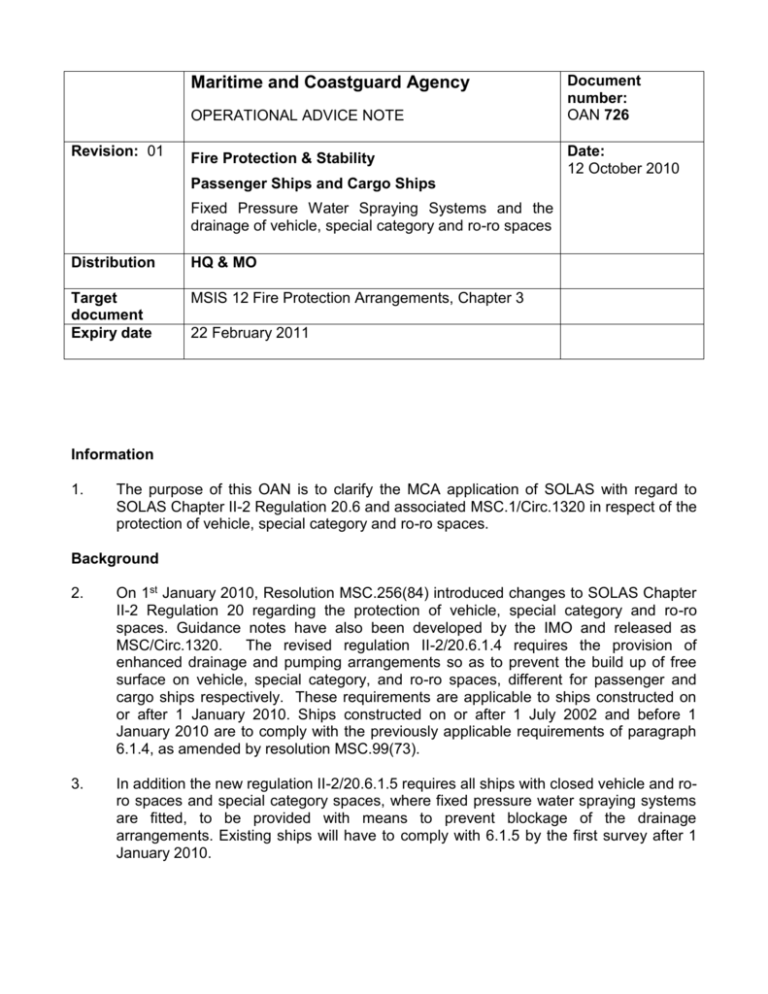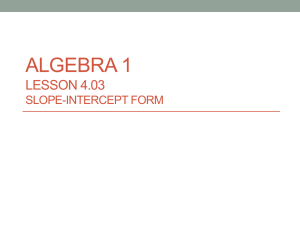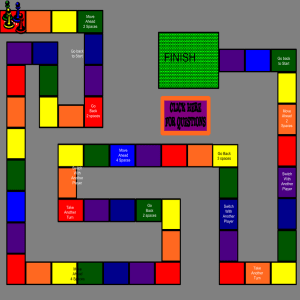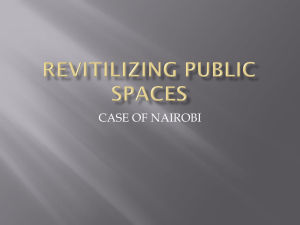OAN 726 - Fire Protection & Stability Passenger Ships
advertisement

Maritime and Coastguard Agency OPERATIONAL ADVICE NOTE Revision: 01 Fire Protection & Stability Document number: OAN 726 Date: 12 October 2010 Passenger Ships and Cargo Ships Fixed Pressure Water Spraying Systems and the drainage of vehicle, special category and ro-ro spaces Distribution HQ & MO Target document Expiry date MSIS 12 Fire Protection Arrangements, Chapter 3 22 February 2011 Information 1. The purpose of this OAN is to clarify the MCA application of SOLAS with regard to SOLAS Chapter II-2 Regulation 20.6 and associated MSC.1/Circ.1320 in respect of the protection of vehicle, special category and ro-ro spaces. Background 2. On 1st January 2010, Resolution MSC.256(84) introduced changes to SOLAS Chapter II-2 Regulation 20 regarding the protection of vehicle, special category and ro-ro spaces. Guidance notes have also been developed by the IMO and released as MSC/Circ.1320. The revised regulation II-2/20.6.1.4 requires the provision of enhanced drainage and pumping arrangements so as to prevent the build up of free surface on vehicle, special category, and ro-ro spaces, different for passenger and cargo ships respectively. These requirements are applicable to ships constructed on or after 1 January 2010. Ships constructed on or after 1 July 2002 and before 1 January 2010 are to comply with the previously applicable requirements of paragraph 6.1.4, as amended by resolution MSC.99(73). 3. In addition the new regulation II-2/20.6.1.5 requires all ships with closed vehicle and roro spaces and special category spaces, where fixed pressure water spraying systems are fitted, to be provided with means to prevent blockage of the drainage arrangements. Existing ships will have to comply with 6.1.5 by the first survey after 1 January 2010. 4. SOLAS Chapter II-2 Regulation 3 defines the following: Vehicle spaces - are cargo spaces intended for carriage of motor vehicles with fuel in their tanks for their own propulsion. Special category spaces - are those enclosed vehicle spaces above and below the bulkhead deck, into and from which vehicles can be driven and to which passengers have access. Special category spaces may be accommodated on more than one deck provided that the total overall clear height for vehicles does not exceed 10 m. Ro-ro spaces - are spaces not normally subdivided in any way and normally extending to either a substantial length or the entire length of the ship in which motor vehicles with fuel in their tanks for their own propulsion and/or goods (packaged or in bulk, in or on rail or road cars, vehicles (including road or rail tankers), trailers, containers, pallets, demountable tanks or in or on similar stowage units or other receptacles) can be loaded and unloaded normally in a horizontal direction. Cargo spaces - are spaces used for cargo, cargo oil tanks, tanks for other liquid cargo and trunks to such spaces. Closed ro-ro spaces - are ro-ro spaces which are neither open ro-ro spaces nor weather decks. Closed vehicle spaces - are vehicle spaces which are neither open vehicle spaces nor weather decks. Open ro-ro spaces - are those ro-ro spaces which are either open at both ends or have an opening at one end, and are provided with adequate natural ventilation effective over their entire length through permanent openings distributed in the side plating or deckhead or from above, having a total area of at least 10% of the total area of the space sides. Open vehicle spaces - are those vehicle spaces which are either open at both ends or have an opening at one end and are provided with adequate natural ventilation effective over their entire length through permanent openings distributed in the side plating or deckhead or from above, having a total area of at least 10% of the total area of the space sides. Actions 5. Noting that SOLAS Ch II-2, Reg 20.6.1.4 and Reg 20.6.1.5 plus MSC.1/Circ.1320 make application to “…closed vehicle, ro-ro spaces and special category spaces…”. 6. The UK interpretation is that the aforementioned Regulations and guidelines are therefore currently applicable separately to "closed vehicle" spaces, "ro-ro" spaces and "special category" spaces. Since “closed” only relates to vehicle spaces it means that SOLAS Ch II-2, Reg 20.6.1.4 and Reg 20.6.1.5 plus MSC.1/Circ.1320 are applicable to all ro-ro spaces (both "open ro-ro spaces" and "closed ro-ro spaces"). 7. Notwithstanding the above interpretation. The MCA believe that IMO may not have given enough consideration to precisely defining the applicability of SOLAS Ch II-2, Reg 20.6.1.4, Reg 20.6.1.5 and MSC.1/Circ.1320. The majority of ‘space’ definitions currently in SOLAS Ch II-2 Reg 3 appear to relate more to ventilation requirements rather than the drainage of any water accumulation and consequent stability issues. The potential for water to accumulate in any vehicle, ro-ro or special category space fitted with a fixed pressure water spraying system, possibly causing a loss of stability, is a serious safety concern. In order to address this matter and until IMO are able to look at this issue in closer detail, MCA are of the opinion that the aforesaid Regulations and Guidance should be applicable to anywhere where fixed pressure water-spraying systems are fitted and where there is the possibility of water accumulation. 8. The intention of SOLAS Ch II-2, Reg 20.6.1.4, Reg 20.6.1.5 and MSC.1/Circ.1320 is to avoid large quantities of water accumulating on deck during the operation of water fire fighting systems. Surveyors should therefore ensure that whatever arrangement is finally accepted that this goal is achieved. Freeing Ports 9. The minimum drainage capacity as calculated in MSC.1/Circ.1320 may be achieved in spaces above the bulkhead deck through the use of scuppers, freeing ports or a combination thereof. The requirements of SOLAS II-2 Regulation 20 paragraph 6.1.5. as elucidated in paragraph 5 of MSC.1/Circ.1320 are not applicable to freeing ports and thus protective gratings are not required. It is to be noted that the fitting of gratings to freeing ports may be detrimental to their effectiveness. Guidance on the application of 6.1.5 to existing vessels 10. Paragraph 5 of MSC.1/Circ.1320 provides the following guidance on the protection arrangements required by SOLAS II-2 Regulation 20 paragraph 6.1.5: 5 Protection of drain openings 5.1 An easily removable grating, screen or other means should be installed over each drain opening in the protected spaces to prevent debris from blocking the drain. The total open area ratio of the grating to the attached drain pipe should be at least 6 to 1. The grating should be raised above the deck or installed at an angle to prevent large objects from blocking the drain. No dimension of the individual openings in the grating should be more than 25 mm. 5.2 No grating or screen is required when a fixed mechanical system is provided to unblock the drainage system, or when other than a gravity drain system is provided with its own filter. 5.3 A clearly visible sign or marking should be provided not less than 1,500 mm above each drain opening stating, “Drain opening – do not cover or obstruct”. The marking should be in letters at least 50 mm in height. 11. The following points provide guidance on the number of drain openings required to be fitted with means of protection and other considerations that may apply to existing vessels. 12. Number of drain openings to be protected - The number and capacity of drain openings to be protected should be calculated according to the procedure outlined below in steps a to d: a. The drencher pump capacity is calculated from the requirement to provide water application at 3.5 l/m2 for low deck height spaces and 5 l/m2 for high deck height spaces for the two largest adjacent drencher sections. (IMO Resolution A.123(V) adopted 1967). b. The drainage requirement is calculated using the requirements in force at the time the ship was built. If these are not known then the drainage capacity is to be taken as 125% of the sum of the drencher pump capacity for the entire space plus the capacity of two fire hoses (four if carrying dangerous goods). c. The quantity of water each drain opening is able to remove should be calculated. This calculation will involve the physical dimensions of the drain, its elevation above the discharge point, the nature of the drainage pipe and valve arrangement and minimal water on deck to offer a pressure head. Account should be taken of head losses in the arrangement. d. Using the above the minimum number of drain openings which should be protected may be calculated. Any drains fitted in excess of this requirement are not required to have protection fitted, unless drainage cannot be obtained under normal drencher test conditions with these drainage openings temporarily closed (i.e. they may be excess in numbers or capacity, but are essential to provide adequate drainage). 13. The protected drain openings should be evenly distributed fore and aft, port and starboard. 14. In respect of drain opening protection arrangements and design: i. Due to variations in design to meet differing situational requirements it is impractical for MCA to recommend any fixed design or designs over another. It will be for the shipyard/vessel owner to submit their designs for review and acceptance by MCA. ii. Each drain opening which is protected in order to comply with the regulation must be fitted with an easily removable raised grating that complies with the requirements of 5.1 of MSC Circ. 1320. The total open area ratio of the grating to the drain pipe should be at least 6:1. iii. The grating should be designed in such a way that the effectiveness of the existing drain is not reduced and to minimise any sill created by the design. If the design of the protection is such that there is any doubt about the retained effectiveness of the drain, then a practical test should be carried out whereby the drain is boxed off and a known quantity of water discharged through the drain without the protection in place and then with. There should be no difference in the time or quantity of water discharged. iv. Where the protection is fitted to a drain in way of vehicle movements, the protection should be designed to withstand the point loads exerted by the maximum vehicle axle weight. This load should be transferred to the deck without causing excessive point loads. The arrangement of the protection may provide for openings at the ships side or similar protected location to be led to the existing drain. Confirmation of the acceptability of any proposed arrangements with regard to deck strength should be obtained from the relevant Class Society. 15. Drain openings which have been identified as excess to the required drainage capacity may be left un-protected. During testing of the efficacy of the drainage system (see point 14 below) these drains should be temporarily blanked to emulate the situation where they are all blocked and only the protected drain openings remain for drainage. The un-protected drains should not be permanently blanked off. 16. The revised arrangements will be tested as part of the usual drencher and fire hose testing regime at both PSSC and SEC renewal. Drainage requirements are expected to be met with any unprotected drain openings temporarily blanked off. 17. Each case will need to be considered individually by MCA. When satisfied with the arrangements the MCA Marine Office dealing with the survey will issue a letter to the ship confirming acceptance. Author Branch Head of Ship Safety Paul Owen Authorised by Branch Assistant Director Seafarers & Ships Paul Coley






